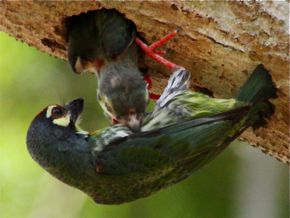“It is always exciting and a pleasure to observe nesting birds. A pair of Coppersmith Barbets (Megalaima haemacephala) had built their nest in a dead branch of a tree. At an estimated height of 4 metres, it was in one of four cavities on the underside of this branch. A chick was observed residing in one of the cavities.
“Both parents took turns to feed the chick, arriving near the top of the tree before descending cautiously to the nest. At times, they arrived within seconds of each other. One had to wait while the other carried out its duty. Over a period of one hour, from 11:00 am to 12:00 noon, there were 14 feedings recorded. During this period, two occasions were observed of an adult entering the nesting cavity and then reappearing with a mouthful of waste in its beak. It will then shoot out like a rocket to dispose it in some unknown place.
“About 70% of the food delivered consisted of fruits, probably figs (above left). These were usually brought in by large mouthfuls. The remaining were insects (above right). These were difficult to spot as they were hidden inside the barbet’s broad, huge beak. Only the dangling legs that were partially exposed outside the beak gave the insects away; probably too long even for the barbet’s huge beak.
“An interesting and somewhat strange behaviour of the barbet chick was observed. The chick would sometimes interact with the adult by extending its head out of the nesting cavity, opening its beak to give the adult one or two ‘bites’. The images captured revealed that the ‘bites’ were aimed mostly at the breast and sometimes nearer the belly (above left). The throat was also ‘bitten’ on one occasion (above right). This behaviour happened after food had been deposited into the chick’s wide gape. It did not happen every time; but were observed for about half of the feeding sessions. The adult barbet did not seem perturbed by the ‘bites’ and feeding may continue after this behaviour.
“Interestingly, a picture showing the same behaviour could be found in the archives of the BESGroup website. ‘Nesting of the Coppersmith Barbet’ contributed by Mike Tan was posted on 8th May 2009. I believe that this behaviour may be common for this particular species.
“Could this strange behaviour be due to:
1. communication with the adult?
2. comfort behaviour?
3. begging behaviour?
4. stimulating the adult to regurgitate food?
5. cleaning of mandibles?
“It would be interesting to understand this strange behaviour.”
Kwong Wai Chong
20th April 2010
Note: The chick may be harassing the adult (after being fed) for more food.













2 Responses
I did know that gull chicks would stimulate parents to regurgitate by pecking on the red spot at the lower middle part of the lower mandible, or probably some other dark colors in different species. These are probably similar in the sense of begging for food/stimulating a regurgitation? Interesting….